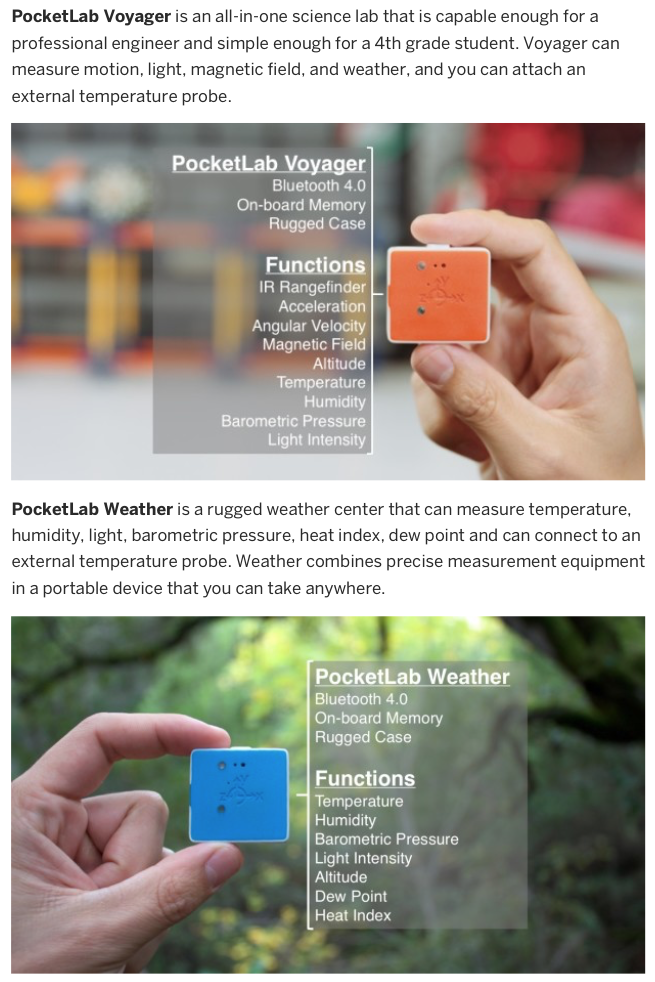Videographing with The PocketLab: Experimental Imagination Unplugged
By Martin Horejsi
Posted on 2017-03-12
Imagine a little white box of about 30 cubic centimeters or a third of the size of a deck of cards. And only 23 grams. Now imagine that that little box can effortlessly and wirelessly measure and share data about motion, acceleration, angular velocity, magnetic fields, pressure, altitude, and temperature all streaming on demand to your phone, tablet, or computer.

The battery-powered PocketLab shares information with a Bluetooth-connected tablet or phone. The PocketLab App makes connection easy, and then the simplified interface that makes visualizing data enjoyable. But that’s not the best part. What really drops jaws is when the PockeLab combines efforts with the smartphone or tablet’s camera. When the two work together creating an augmented reality perspective that has a graphical overlay on what the camera sees. What that means is that you can both see the data as it is collected at the same time you see what is creating the data.

The Nevada Ready 21 program zeroed in on the PocketLab for their statewide tech integration that used the Chromebooks as its tech hub. According to the NR21 website, “PocketLab® is a science lab that connects to the CTL NL6 Chromebook and fits in a pocket. PocketLab allows students to explore the world and build science experiments using integrated sensors including: Accelerometer; Gyroscope; Magnetometer: Pressure and Temperature. PocketLab has many of the same features as lab equipment that costs thousands of dollars but is simple to use, deploy and manage and is included with the CTL NL6 Education Chromebook as part of CTL’s solution for NR21.”
The PocketLab is a collection of microsensors piled into a small battery-operated Bluetooth-enabled rectangular block. Controlling the block with an App, the student can choose any of the sensors and collect realtime data with it.
The PocketLab App’s augmented reality tangent is accessed through a little icon in the upper right that connects the phone/tablet camera with the App. Instantly the data stream is overlaid in graphical form on top of a video stream of what is generating the data (or wherever the camera is pointed).
One issue to note, however is that to combine the graphical data over the video takes time to render. It’s a slow process where in my tests it took about 12 seconds of rendering time for each second of videographing. So a minute of videography will take 12 minutes of rendering.
Here is the operating manual for iOS. And for Android. And Chromebook.
The PocketLab runs on a single CR2032 button battery that is easily replaceable. Its expected that a student will get between 40 and 400 hours of PocketLab operation out of one battery depending on data rate and sensors used. Here’s a video of how to change the battery.
The Pocket lab sells for about $98 for one, with discounts for multiple units and classroom sets. Although PocketLab should take a drop up to two meters, a silicon bumper case is available as well for those rougher assignments.
The future looks bright for the PocketLab family with several new additions on the horizon. Due to a successful Indiegogo campaign, The PocketLab Voyager and The PocketLab Weather have onboard memory to collect data on their own, and then share via Bluetooth when the PocketLab returns from it’s adventure.
From the Indiegogo Website:

The creativity of experimental design is set free with the PocketLab. But when coloring between the lines, PocketLab provides a helpful guide to connect activities with the New Generation Science Standards (NGSS).
And here is a small taste of PocketLab examples posted on YouTube.
Disclaimer: The views expressed in this blog post are those of the author(s) and do not necessarily reflect the official position of the National Science Teaching Association (NSTA).


